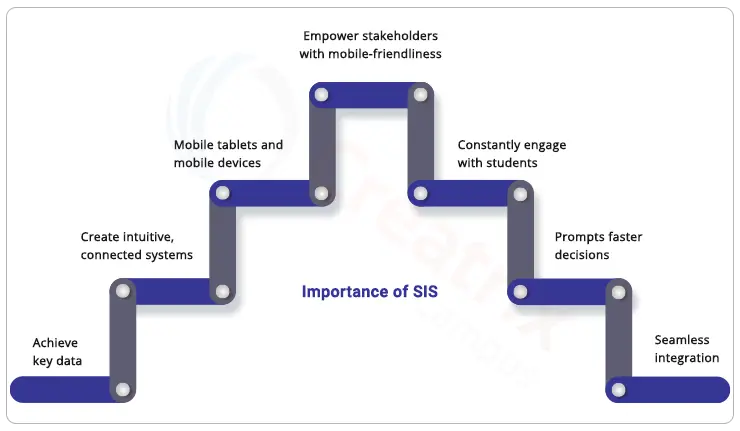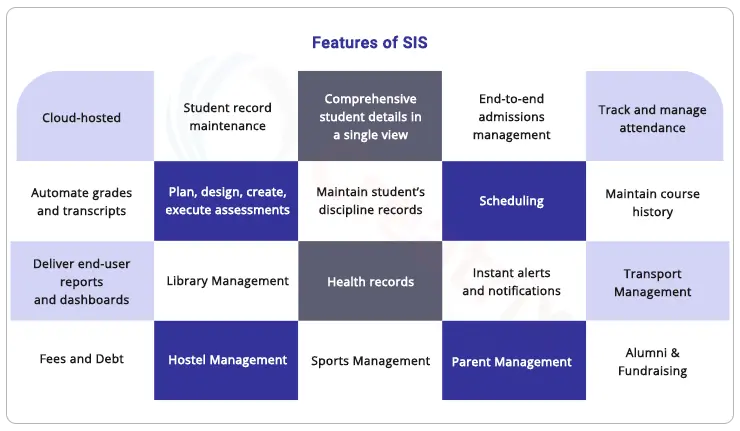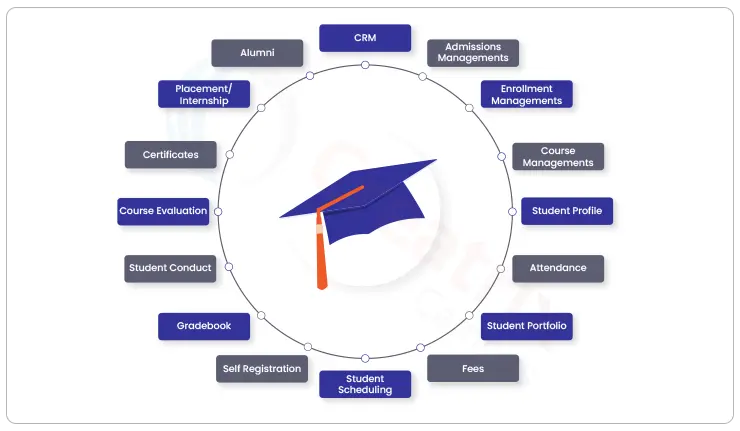Studying the student information system features before making a purchase is vital to delivering an engaging experience your students most expect these days. As an institutional decision-maker, do you agree with this? If yes, then this blog is for you who are looking for an effective tool to manage your constituents in the most modern way.
The market for SIS is showing signs of accelerated change. Let's take a look at the top 20 features of a student information system that has the power to unite campus, engage with students throughout their journey, and empower constituents throughout the institution.
.webp)
A web-based activity that centralizes all student information from the previously stored legacy systems with automation is SIS. It manages all data related to student grades, performance, attendance, interpersonal records, and more by giving role-based access to the stakeholders involved with 100% data security. Thus with the student information system institutions can efficiently manage both academic and administrative processes, with a high level of preciseness, and error-free. They can even personally support students’ needs through their ups and downs.
What is the purpose of SIS (Student Information System)?
The real purpose behind the student information system is to streamline the entire student information and make it accessible, so higher education campus leaders, faculty, academicians, and students have data right in their hands with no fuss. It generates multiple reports, reduces manual workload, and allows faculty to invest quality time in education, by improving students’ performance.
In short, an SIS easily manages
- Online admissions, inquiries
- Online exam
- Student data and student profile
- Attendance
- Schedules and Curriculum
- Attendance and LMS
- Fee, billing
- Grade book, conduct, certificate
- Program & course management
- Business analytics, reporting, and more
Why is the student information system important in higher education institutions?
Here are the Student Information System benefits and findings regarding why the SIS is important for educational institutions.
- Achieve key data that is most relevant to you with dashboard analytics
- Create intuitive, connected systems and innovative user experiences for all constituents
- Deliver services through tablets and mobile devices for today’s tech-savvy students
- Empower stakeholders with access to information with timely & personalized notifications
- Engage with the students from being a prospect to enrolled students, to alumni
- Integrate seamlessly into your third-party system or use Creatrix with its LMS, Assessment systems
- Take faster and smarter decisions with a 360-degree view of your institution

Top Student Information System features
Managing a campus needs careful planning and time management of the whole constituent involved in the process. An automation system like a student management system is expected to have extensive on-demand reporting features with analytics and compliance readiness. Here are more features of the student information management system that every SIS is expected to have.

20 Highly Efficient Features of Student Information System
A student information system (SIS) is a software application designed to manage and organize data related to student records, including personal information, academic performance, attendance, and other student-related information.
Some key features of a student information system include:
1. Cloud-hosted
Higher education decision-makers know how valuable cloud-hosted ERP is when it comes to managing costs and improving efficiency across the institution. Cloud-enabled SIS selections are being increasingly implemented by all types of educational institutions to manage and store all data to reduce huge investments, save time, and optimize resources.
An efficient cloud-hosted SIS has a flexible architecture with a greater amount of personalization and configuration options. Institutional heads get deeper insights, all in the cloud, which gives them total visibility into the students’ progression, academic planner, courses, etc.
2. Student record maintenance - reports, dashboards, and analytics
With the ability to track student behavior with data insights, an SIS can be an institution’s success point. Most Student Information Systems come with native reporting and unified data core features that handle the power of data into the hands of end-users.
They display data in respective dashboards, with configurable reports on students' learning outcomes, grades, performance, fees, attendance, schedules, and events. The extensive on-demand reporting system facilitates institutional heads to make critical decisions for betterment.
3. Comprehensive student details in a single view
Most modern Student Information systems come with this feature. They provide a complete student portfolio with details about the profile, enrollment, course self-registration, assessments, outcomes tracking, library, publications, research, and more. They can sync all details like promotions, graduations, degree paths, communities, transcripts, and report cards for better insights.
4. End-to-end admissions management
The SIS has the power to automate the entire enrollment and admission process under a single platform. This way there is no need for a huge bundle of disparate files and data; the instant search option makes data accessible in a single shot.
It helps eliminate manual admission processes and process automation, which enables institutions to track the entire recruitment from inquiries and applications to admission and enrollment and help students achieve success. The automated notification features and standard responses save a lot of administrative time.
5. Track and manage attendance
The SIS’s yet another feature is to maintain student attendance securely and generate related on-demand reports for various stakeholders. This feature helps institutions minimize proxies and paperwork. With instant automated SMS and email alerts triggered about student absenteeism, parents can stay vigilant over their wards' performance.
6. Automates grades and transcripts
A typical grade book automation in SIS offers easy access to faculty, students, and parents to apply and track the same. The option allows stakeholders involved to edit, send, and maintain grades and transcripts to any destination in just a few clicks, thereby improving the service and convenience to students and alumni. With customization options, whenever you use a number grading system, the program can be configured to fit all your needs.
7. Plan, design, create, and execute assessments of all kinds
This feature allows effective planning, designing, creation, and execution of all kinds of assessments including quizzes, assignments, unit tests, MCQs, etc in simple clicks.
Most SIS integrate with third-party assessment platforms to effectively conduct anonymous and planned online tests. They even have the option to create templates and questions, set time limits, prevent question backtracking, and automatically grade students.
8. Maintains student discipline records electronically
It’s indeed challenging to maintain discipline within higher education campuses. The rising number of incidents has prompted higher education institutions to depend on software. SIS can be a single interface for reporting, maintaining, tracking, disciplinary issues, and generating actionable reports to compare and analyze the overall discipline variance across departments and programs.
Most advanced Student information systems (SIS) keep parents informed about their children’s academic achievement, co-curricular, and discipline as a preventive action before being suspended. This kind of initiative improves student safety, security, and accountability.
9. On-the-go scheduling
An SIS with an inbuilt scheduling feature is a drawing card. Between handling multiple institutional requirements like course requests, enrolling students, maintaining grades, and conducting assessments, scheduling can become a mammoth task to maintain and execute.
With advanced and powerful tools, the SIS can help institutions accomplish their scheduling goals, by maximizing course fulfillment and minimizing conflicts—all by saving resources and time.
10. Maintain course history
An SIS maintains the detailed course history of the student(s) in a simple and fast manner. Role-based dashboards give a clear view of past and current courses, along with students’ academic progress, GPA, grades, and outcomes. Present-day SIS has essential requirements related to admission, course, and syllabus, accounts, or fees are indexed and classified for easy access.
11. Delivers end-user reports and dashboards
The next crucial feature that an SIS comes integrated with is workflow rules for built-in reporting and analytics. Institutions have tons of data that don’t make sense most of the time since they are in silos.
An SIS with a data reporting feature makes it easy to get a complete picture of the student lifecycle so you can make more informed decisions.
This gives an opportunity for teams the granular level of reporting that they need for accreditation requirements and other ad hoc analyses, all within the applications they use every day. The dashboard combining graphical data over the years across the institution allows you to raise the bar by comparing performance.
12. Library Management
Today’s students need access to additional resources and advanced library management is vital to any educational institution. An SIS can make it a reality. Students have the option to find, search, locate, issue, and return books with customized search options. The system even allows users to view borrowed books, place books on hold, request books, renew membership, handle fines, and create reports, all by themselves. This conveniently saves the amount of time spent manually. Some of the interesting features to look for in an SIS are book recording, online reservation, smart and intuitive search options, course libraries, etc.
13. Health Records
The Student Information System has convenient tools to monitor students’ health including medication and health alerts, logs for nurses, health screenings, and individual health plans. There are workflows to capture and track compliance monitoring and reporting based on institutional requirements. In short, an SIS gives a complete database of a student's medical history just one click away.
14. Instant alerts and notifications to keep constituents informed
SIS comes with the ability to either send mass notifications or messages individually with simple configurations. Educational institutions can send important notices and announcements using the robust communication system which enables them to send notifications and alerts to students, teachers, staff, and parents via email, SMS, and Messaging.
15. Transport Management
Completely student-centric, this feature allows institutions to monitor and track every detail about student transportation, ensuring the safety of the students, to and from the campuses.
16. Online fee management
This feature of SIS lets students easily manage student fee payments and discounts. On immediate login, students can see all that they need to know about financial aid, installment, scholarships, and debt management.
SIS with a mobile app allows students and parents to pay fees from their favorite device, ensuring hassle-free fees fee collection, without any error. The Instant notification alerts through emails and SMS allow users about the payment made, making the transaction more transparent and secure.
17. Hostel Management
Manage and maintain records including those of hostellers, guests, and mess bills, in an organized way. The system generates student details and keeps track of their room and availability. While students gain trust with this feature by picking preferences and requirements of their choice, the management can improve transparency by being able to configure room availability, allocate rooms, auto-generate room numbers, and configure fees, and facilities charges.
18. Sports Management
An SIS has information on athletic or sports eligibility. Stakeholders can manage and cross-check with the health and other information for their eligibility and give training according to it.
19. Parent Management
Today’s parents prefer to receive updates and information about their children electronically and via mobile phones. Understanding this is a crucial step in the development of SIS. Knowing this is the first step in increasing parent engagement. An SIS is built to give parents priority in their children’s education.
Parents will get complete information on their child’s activities and test assessments. It gives a sense of relief to parents knowing they can access child information from anywhere about their progress, absenteeism, performance, and fee alerts, so they can raise the child in the way they aspire.
20. Alumni & Fundraising
Building and engaging alumni connections have become the need of the day—a platform that triggers alumni interaction where a lot of ideas and thoughts flourish for institutional betterment. Using the SIS, target and track the influential alumni network and donors for fundraising, membership, career advancement, and business exchange.
Even after their graduation, institutions can keep track of their students, and their careers and involve them in future curricular aspects.
Creatrix SIS platform and how it can transform higher education institutions
Creatrix Student Information System is a mobile-first, comprehensive solution that guides and automates every aspect of the student lifecycle from recruitment, marketing, enrolment, academic, finance, and placements with integrated cloud capabilities. It holistically takes care of your student’s needs and backs it with deployment services, training, support, and continuous innovations to help you use technology with confidence as your institution evolves constantly.

The modules combine value-added solutions from Recruitment, Admissions, CRM & Marketing to Alumni, and Fundraising and have top-notch administrator tools with intuitive reports, smart alerts, and dashboards for smarter decisions for improving student progress; with our platform faculty can offer personalized support to learners. Our mobile app is the icing on the cake.
We believe that each customer is unique and has different requirements and goals, so our student information system is engineered to handle a variety of needs and learning styles.
To help you reach your goals faster and empower your teams, contact our team. Schedule a demo if you wish to know how we have underpinned student success and improved institutional effectiveness in institutions across 15 countries.
Want to contribute?
We welcome thought leaders to share ideas and write for our blog.
Become a Guest Author →

